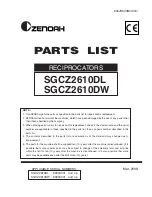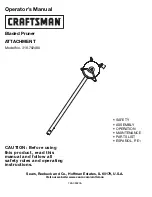
24
ENGLISH
WARNING:
To avoid a kickback and to avoid serious
personal injury, never position the concave edge of
bowed or warped material against the fence.
The compound miter saw does an excellent job of cutting
crown molding. In general, compound miter saws do a
better job of cutting crown molding than any other tool.
In order to fit properly, crown molding must be compound
mitered with extreme accuracy.
The two contact surfaces on a piece of crown molding that
fit flat against the ceiling and the wall of a room are at
angles that, when added together, equal exactly 90°. Most
crown molding has a top rear angle (the section that fits flat
against the ceiling) of 52° and a bottom rear angle (the
section that fits flat against the wall) of 38°.
Fig. 33
Cutting crown molding
To use this method for accurately cutting crown molding for
a 90° inside or outside corner, lay the molding with its broad
back surface flat on the miter table and against the fence.
When setting the bevel and miter angles for compound
miters, remember that the settings are interdependent;
changing one angle changes the other angle as well.
Keep in mind that the angles for crown molding are very
precise and difficult to set. Since it is very easy for these
angles to shift, all settings should first be tested on scrap
molding. Also most walls do not have angles of exactly 90°;
therefore, you will need to fine tune your settings.
When cutting crown molding by this method, the bevel
angle should be set at 33.85°. The miter angle should be set
at 31.6° either right or left, depending on the desired cut for
the application. See the chart below for correct angle
settings and correct positioning of crown molding on miter
table.
The settings in the chart below can be used for cutting All
Standard (U.S.) crown molding with 52° and 38° angles. The
crown molding is placed flat on the miter table using the
compound features of your miter saw.
Laying molding flat on the miter table
(Fig. 35)
When cutting warped material, be certain that the material
to be cut is positioned on the table with the convex side
against the fence, as shown Fig. 34a.
If the warped material is positioned the wrong way as shown
in Fig. 34b, it will pinch the blade near the end of the cut.
Cutting warped material (Fig. 34a-34b)
Fig. 34a
Correct
Bevel Angle
Setting
33.85°
Type of Cut
Left side, inside corner
1. Top edge of molding against fence
2. Miter table set right 31.62°
3. Save left end of cut
Fig. 34b
Incorrect
33.85°
Right side, inside corner
1. Bottom edge of molding against fence
2. Miter table set left 31.62°
3. Save left end of cut
33.85°
Left side, outside corner
1. Bottom edge of molding against fence
2. Miter table set left 31.62°
3. Save right end of cut
33.85°
Right side, outside corner
1. Top edge of molding against fence
2. Miter table set right 31.62°
3. Save right end of cut
Содержание CMXEMAX69434501
Страница 2: ......




































